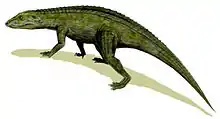Zosuchus
Zosuchus ("Zos [Canyon] crocodile") is a genus of basal, Late Cretaceous crocodyliform from the Mongolia.
| Zosuchus Temporal range: Late Cretaceous | |
|---|---|
| Scientific classification | |
| Kingdom: | Animalia |
| Phylum: | Chordata |
| Class: | Reptilia |
| Clade: | Mesoeucrocodylia |
| Genus: | †Zosuchus Pol and Norell, 2004 |
| Species | |
| |
The type species is Z. davidsoni, after Amy Davidson.
Discovery
It was found in the Redbeds of Zos Canyon (Djadokhta Formation) in the Gobi Desert of Mongolia by expeditions organized by the American Museum of Natural History, and described by palaeontologists Diego Pol and Mark Norell in 2004.
Material of Z. davidsoni consists of five specimens:
- IGM 100/1305 (holotype): isolated skull and lower jaws
- IGM 100/1304
- IGM 100/1306
- IGM 100/1307
- IGM 100/1308
Morphology
This genus had a very short snout.
Systematics
Pol & Norell (2004) found Zosuchus davidsoni to be sister to Sichuanosuchus and Shantungosuchus, the three forming a basal clade of crocodyliforms based on the presence of a ventrally deflected posterior region of the mandibular rami. A 2018 cladistic analysis found Zosuchus, along with Sichuanosuchus, Shantungosuchus, and Shartegosuchidae, to form a basal mesoeucrocodyliform clade, Shartegosuchoidea.[1]
Sources
- Kathleen N. Dollman; James M. Clark; Mark A. Norell; Xu Xing; Jonah N. Choiniere (2018). "Convergent evolution of a eusuchian-type secondary palate within Shartegosuchidae". American Museum Novitates. 3901: 1–23. doi:10.1206/3901.1.
- Pol, D. & Norell, M. A., (2004). "A new crocodyliform from Zos Canyon, Mongolia". American Museum Novitates 3445: 1-36.


